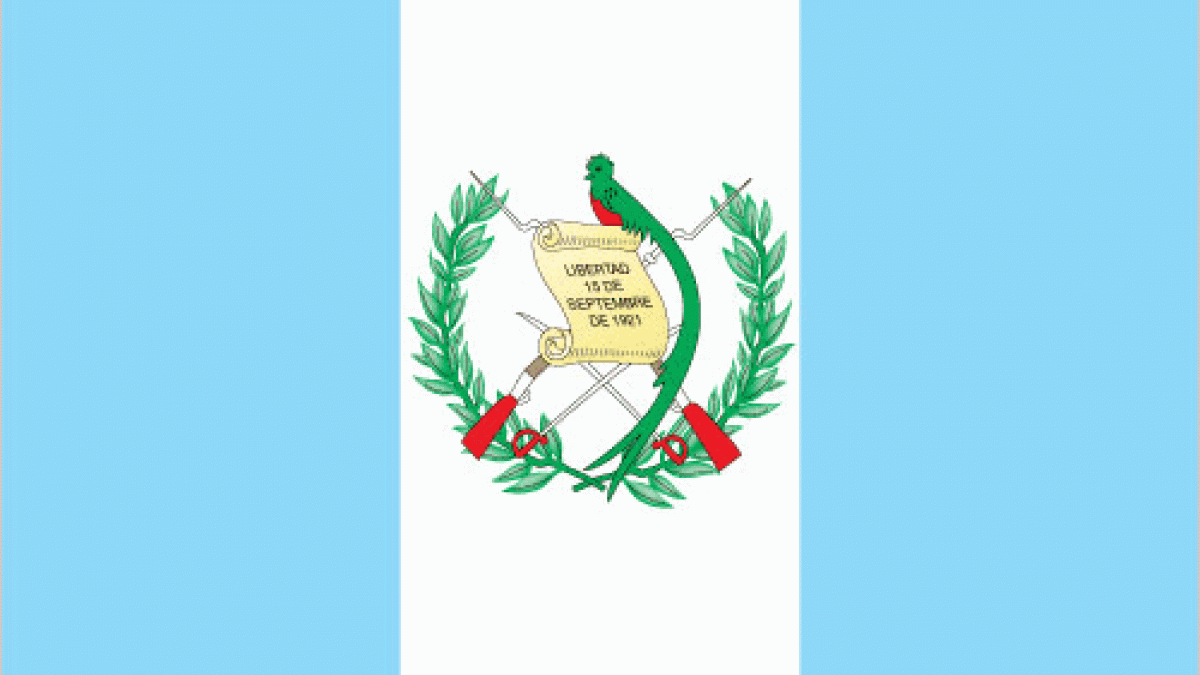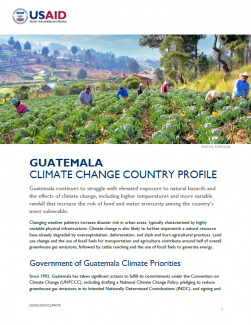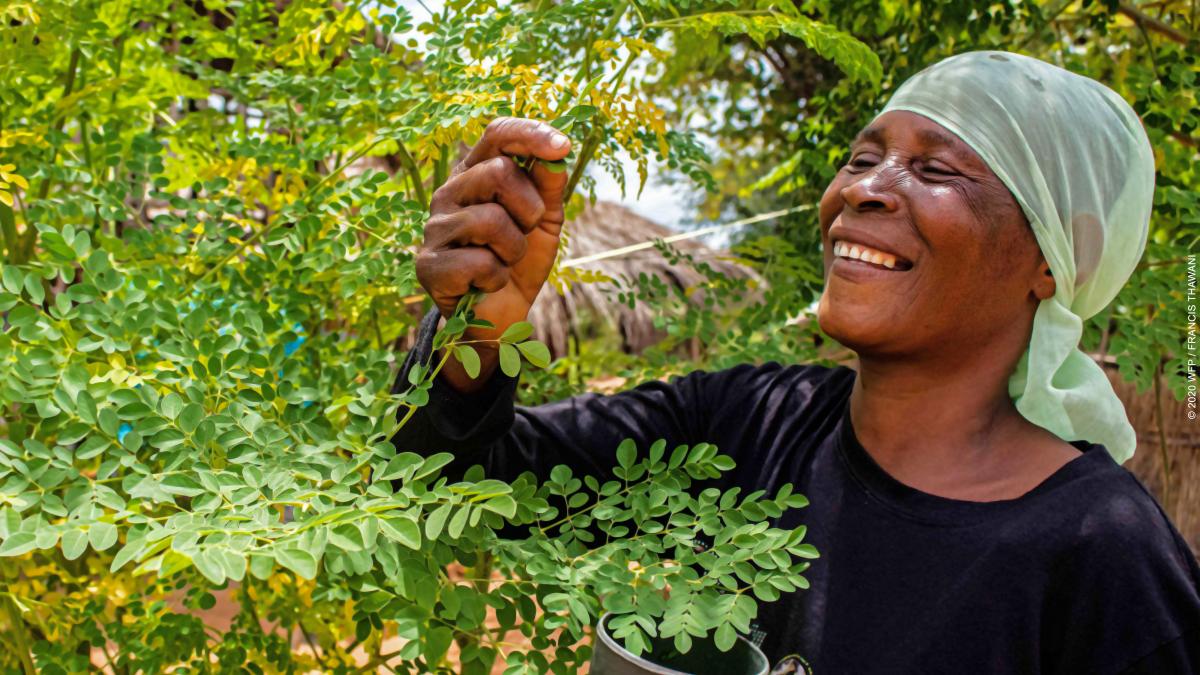Changing weather patterns increase disaster risk in urban areas, typically characterized by highly unstable physical infrastructure. Climate change is also likely to further impoverish a natural resource base already degraded by overexploitation, deforestation, and slash and burn agricultural practices. Land use change and the use of fossil fuels for transportation and agriculture contribute around half of overall greenhouse gas emissions, followed by cattle ranching and the use of fossil fuels to generate energy.
Government of Guatemala Climate Priorities
Since 1992, Guatemala has taken significant actions to fulfill its commitments under the Convention on Climate Change (UNFCCC), including drafting a National Climate Change Policy, pledging to reduce greenhouse gas emissions in its Intended Nationally Determined Contributions (INDC), and signing and ratifying the Paris Agreement. Guatemala has a National Climate Change Policy and one of the first climate change laws in the world: The Framework Law on Climate Change. Under this law, Guatemala created the National Climate Change Council, which serves as a regulatory body for the country’s key sectors. Key goals relating to mitigation and adaptation under Guatemala’s Nationally Determined Contributions include:
- The Government of Guatemala endorsed the National Low Emission Development Strategy (LEDS), developed with the support of USAID, as the official strategy for climate change mitigation in the country. The strategy was presented by the Ministry of Foreign Affairs and the Ministry of Environment and Natural Resources to the Executive Secretary of the United Nations Framework Convention on Climate Change (UNFCCC) in November 2020.
- The reduction of 11.2 percent of its total GHG emissions from the 2005 base year projected to 2030; this reduction means that emissions in a baseline scenario (BAU) of 53.85 million tons of CO2 equivalent for the year 2030, will be reduced to a value of 47.81 million tons of CO2 equivalent in that year.
- The reduction of 22.6 percent of its total GHG emissions from the 2005 base year by 2030 contingent upon technical and financial support from new and additional international public and private resources.
- The development of Early Warning Systems and unification of climate information to reduce disaster risks linked to extreme weather events and a changing climate.
USAID’S Climate Change Program: Objectives and Results
USAID supports the Government of Guatemala’s development and climate priorities through a series of complementary programs and partnerships across the climate adaptation, renewable energy, and natural climate solutions sectors.
Adaptation
USAID enhances the resilience of communities and livelihoods within Guatemala’s Western Highlands and Verapaces, the country’s most vulnerable regions to climate change. These are the highest priority regions for capacity building in climate change adaptation due to their strong dependence on agriculture, high levels of poverty, proximity to Mexico, and high rates of outward migration.
Feed the Future (FTF): USAID/Guatemala’s FTF value chain activities apply an integrated approach to watershed, land-use and water resources management. FTF activities also promote the use of agroforestry and climate smart agriculture technologies to increase the resilience of crops and soil to extreme weather events and climate pressures, while increasing overall productivity. These technologies include drip irrigation, water catchments, improved seed/tree varieties, soil fertility management and conservation, biopesticides and locally produced organic fertilizers, and locally appropriate agro-structures such as greenhouses, micro and macro tunnels, and screen houses that provide physical protection from heavy rain and hail.
Results 2017–2022
Climate Smart Practices: 36,823 smallholder producers who are using climate smart agricultural practices on 22,801 hectares of land.
Watershed Restoration: Eighteen watershed management plans have been implemented, directly benefiting 13,334 small-scale producers in a total area of 122,072 hectares, in twelve prioritized municipalities that represent the water recharge areas in the western highlands of Guatemala. Ten thousand additional hectares are proposed for reforestation over the next ten years in coordination with the municipal authorities.
Reforestation: More than 9,500 hectares have been registered in the Government of Guatemala's forestry incentive program, providing a supplemental income of $6.1 million dollars to more than 3,000 families and enhancing the protection of water recharge sources and the conservation of soils and forests in the western highlands of Guatemala.
Coffee Improvements: Agroforestry approaches improved 4,465 hectares of coffee with more rust resistant varieties of coffee, soil conservation, and shade tree reforestation, benefitting 4,160 small coffee producers. Production of local agro-ecological fertilizers are helping 569 small coffee producers improve soil health and coffee yields. From 2017-2022, 1,569,600 coffee seedlings were established in 386 hectares, including varieties with better resistance to drought and pests. In addition, 174,763 fruit and timber trees with high commercial value (avocado, citrus, banana, macadamia, cocoa, orange, peach, and forest species such as cedar and mahogany) were planted in coffee plots of 8,537 small-scale coffee producers (4,459 men and 4,078 women, including 1,010 youth under 30 years of age) to improve coffee agroforestry systems.
Solar Energy: More than 93 coffee solar dryers have been constructed which support 500 smallholder coffee farmers from 36 Cooperatives. Solar tunnels decrease the humidity rate of coffee beans from 65 percent to 11 percent in a shorter period, compared to drying coffee in open field tables, leading to improved quality coffee suitable for export markets.
Natural Climate Solutions
USAID and its partners are mitigating climate change by reducing Guatemala’s primary sources of land-based Greenhouse Gas (GHG) emissions: deforestation and forest degradation in the Petén, Alta Verapaz, and Baja Verapaz departments, and the Western Highlands region. By promoting forest management, USAID helps to increase forest-cover, forest productivity, and rural economic development, to establish agroforestry systems, and to incentivize reforestation and forest restoration. USAID also works to strengthen partner systems for forest fire monitoring on both public and private lands, in order to reduce CO2 emissions. As a result, Guatemala’s community fire brigades, park guards, and other government entities are provided with continual capacity-building support and training to prevent and control forest fires.
To mitigate increased emissions in the Agriculture, Forestry and Land Use (AFOLU) sectors, the Government of Guatemala maintains contracts with community groups in northern Guatemala, in the Maya Biosphere Reserve (MBR), that derive significant income by sustainably managing over 500,000 hectares of Forest Stewardship Council (FSC) certified forests. Between 2020-2022, the Government of Guatemala renewed the community concessions contracts for another 25 years, for a total of 50 years. In 2022, the government established two additional community managed concessions bringing the total to eleven. Through these concessions, community incomes are expected to continue to increase as interest grows in certified sustainable forest products. Of the income generated from sales, community forest concessions invest around 46% in protecting forests against fires and other threats of land use change. To safeguard gains in sustainable forest management, USAID supports periodic evaluations to facilitate the extension of community forest concessions in the Mayan Biosphere Reserve beyond current agreement periods and supports policy initiatives to reinitiate expired or canceled concessions.
Results 2013-2022
Forest Product Development: US$199.1 million in total sales from 25 sustainable and inclusive value chains for forest timber products such as furniture and moldings, non-timber forest products such as xate palm, allspice, and ramon nut, and services such as community tourism.
Forest Sector Job Creation: 61,813 full-time equivalent jobs were created or strengthened (approximately 18 percent women) for work in agroforestry and sustainable forest value chains.
Certified Forest Management: 555,650 hectares (an area six times larger than Shenandoah National Park) of forest certified through Forest Stewardship Council (FSC) certifications which means that forest dependent communities undertake economically viable, socially, and environmentally conscious forest management.
Carbon Sequestration: 2,709,597 tons of greenhouse emissions sequestered (approximately three times more than Washington D.C.’s annual transportation CO2 emissions) and reduced as part of the sustainable management of the Community Forest Concessions in the framework of the Guatecarbon project in the MBR, as well as forest areas in Verapaces and Western Highlands regions.
Renewable Energy
USAID promotes the generation and use of renewable energy and energy efficient and low emissions infrastructure, technologies, and production processes. This includes feasibility studies for a solar energy generating plant in the municipality of Quetzaltenango with an installed power of 1.88 megawatts (MW) which has the potential to generate 4,300 megawatt hours (MWh) annually, reduce CO2 emissions by 1,824 tons annually and provide electricity to 10,000 people.
Clean Energy Training: Almost 400 youth (50% female) are receiving technical training in clean energy as part of technical vocational training or as a complement to sustainable agriculture training.
Finance: USAID is developing new financing mechanisms to help increase investment in renewable energy and energy efficiency in the Western Highlands. Since August 2022, activities have facilitated $4.2 million in investments for the renewable energy sector and reduced carbon emissions by at least 920 tons of CO2. Partnerships with business accelerators and incubators have also facilitated business technical assistance, capacity building, and investment support to 12 renewable energy companies with nationwide outreach, positively impacting more than 1,000 direct beneficiaries in clean energy and climate change activities.
Street Lighting: In the municipality of Huehuetenango, switching street lighting to energy-efficient LED lighting is expected to reduce CO2 emissions by 1,354 tons annually and save 3,385 megawatt hours (MWh) and benefit 60,000 people in the municipality.
Solar Energy: USAID is also promoting the use of clean energy in the Western Highlands, through the installation of solar panels and solar dryers in coffee cooperatives and agriculture schools, thereby reducing labor requirements and operating costs, and creating a better-quality coffee independent of traditional fuel-based dryers. Ten farmers' organizations installed 396 solar panels in their collection centers, cold rooms, and offices to reduce their CO2 emissions and generate cost savings. They expect to reduce more than 85 tons of CO2 originating in their processes and operations and save more than $31,000 USD in energy costs, which will be invested in new community projects to improve farmers' productivity, transform their products, and promote the inclusion of women and youth. In addition, 9 solar panels were installed at six cooperatives in Huehuetenango, two cooperatives in San Marcos, and one in the Camojá Complex to reduce greenhouse gas emissions, minimize the cost of electric power, and increase the competitiveness of small-scale coffee producer cooperatives. In the same region, USAID provided solar panels to schools damaged by Hurricanes Eta and Iota, as part of a project preparing schools to reopen following COVID-19 closures. In addition, through its Guatemala Entrepreneurship Development Initiative, USAID is developing new financing mechanisms to help increase investment in renewable energy and energy efficiency in the Western Highlands.
For More Information




